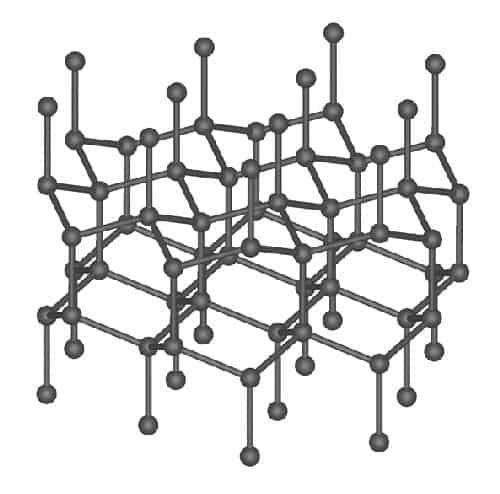Researchers in Australia have discovered that a type of diamond called lonsdaleite can exist independently of normal diamond in a rare type of meteorite. The team, led by Andy Tomkins at Monash University, made the discovery by using electron microscopy to identify the harder form of diamond within ancient meteorites. The team also includes researchers at RMIT University and their results provide strong evidence for how this form of diamond can form in nature, and potentially even be created for industrial applications.
Ureilites are a rare type of meteorite that probably originated in the mantle of an ancient dwarf planet that once existed in the inner solar system. Scientists believe that this planet was destroyed soon after its formation by a colossal asteroid impact. Ureilites contain a great abundance of diamonds, and are also known to contain a form of diamond called lonsdaleite – which could be harder than normal diamond.
The diamonds found in jewelry and industrial tools comprise carbon atoms that are arranged in a type of cubic lattice. In lonsdaleite, however, the carbon atoms in are arranged in a type of hexagonal lattice. The material is named after the British crystallographer Kathleen Lonsdale – who was the first woman elected as a Fellow of the Royal Society and a pioneer in the use of X-rays to study crystals.
Discrete material
Although it can be synthesized at high pressures, researchers had thought that lonsdaleite can only exist in nature as a defect of regular diamond, and not as a material in its own right. To test this theory, Tomkins’ team analysed the crystal structures of ureilite samples using electron microscopy. Their aim was to map the relative distributions of lonsdaleite, diamond, and graphite they contained. For the first time, their results showed that lonsdaleite crystals can indeed exist as a discrete material – typically in the form of micron-sized grains, interspersed with veins of diamond and graphite.

Harder than diamond?
The team’s observations provide the first strong evidence for how these three different phases of carbon formed in ureilites. Based on their results, Tomkins and colleagues suggest that lonsdaleite likely formed out of coarse crystalline graphite as the material rapidly cooled and decompressed, following the destruction of the ureilite-forming dwarf planet.
This reaction was enabled by the presence of a supercritical fluid (where distinct liquid and gas phases do not exist), containing a variety of compounds of carbon, hydrogen, oxygen, and sulphur. As this process continued, the researchers suggest that much of this lonsdaleite would have been converted into diamond, and then back into graphite.
Tomkins’ team also draw parallels between this process and industrial chemical vapour deposition – where vapourized precursors react on the surfaces of solid substrates to produce thin, solid films. By mimicking this process in the lab, they hope that their insights could pave the way for new techniques for manufacturing lonsdaleite – which could replace regular diamond in industrial applications that require the hardest materials available.
The research is described in Proceedings of the National Academy of Sciences.













